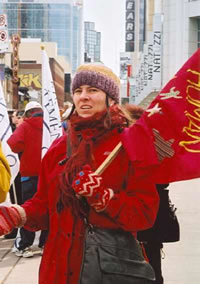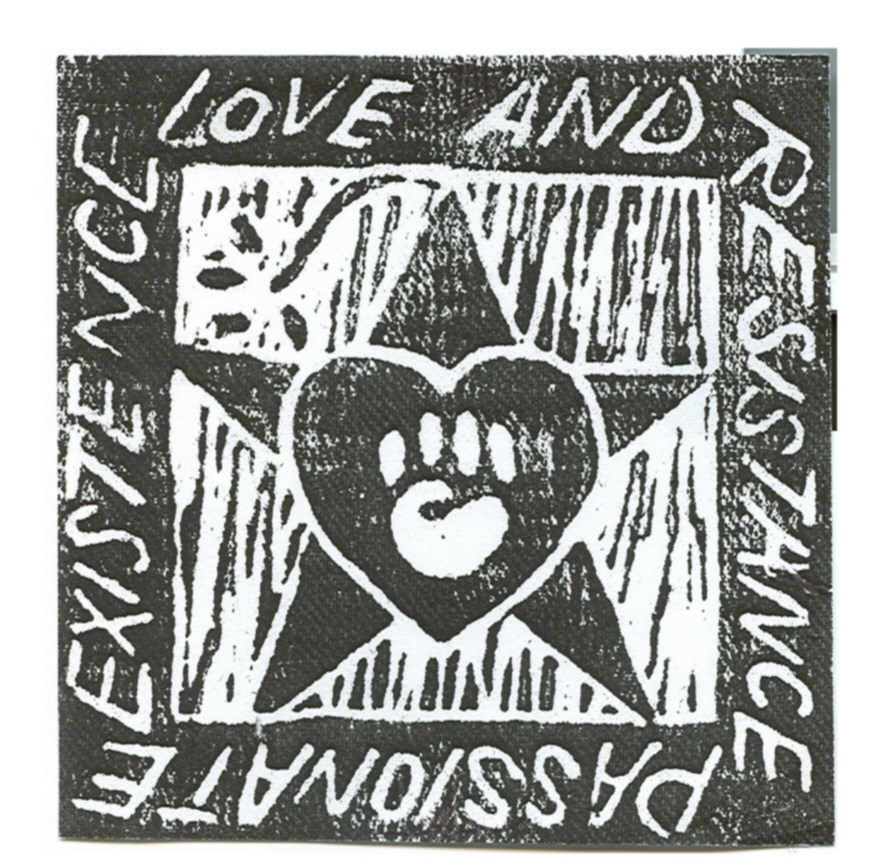by Oona Padgham
Why flags? While the trusty banner has its place at demonstrations and protests, flags have many advantages to banners. Banners can be cumbersome and difficult, especially in windy weather. You need two people to carry a banner. In cold weather, keeping that banner up can make for very cold hands. And then there is always the mad scramble to find the banner before an event. Who had it last? Is it in someone’s car? Is it at an office? Who will bring it to the event?
Flags avoid the complication of locating the banner. Everyone is responsible for bringing their own flag. Only one person is needed to carry a flag, but you can also create a powerful visual impact by coordinating many flags.
Flags are very manageable. Slide them off the post, and they fold up small. And you don’t even have to take a post with you to an event. At most events you can find a picket sign stick that you can use as a post.
The post of the flag can be stuck in a pocket, keeping your hands free. Most of all, flags are fun to make and pretty to look at. You can also hang them out your window or off your porch to get your message across any day of the year.
These instructions and photos are from a day of flag making with the Toronto based group Latin American Coalition Against Racism (LACAR). Visit their website at http://latinosagainstracism.tao.ca
What you need:
Fabric
Acrylic paint
Paintbrushes
Scissors
Cardboard
Fabric scraps
Heat & bond interfacing (optional)
Iron (for the interfacing)
Posts (bamboo sticks, pickets posts, dowelling, etc)
Step 1: Preparation of the flag
Tear or cut the fabric into appropriate sized pieces (3ft by 5ft is a good size). If you are either ambitious or a perfectionist, you can hem all the edges of the flag, but it is not necessary. A note on fabric selection: you want something durable, but not too heavy. Light to medium weight cotton or nylon lining works well and is inexpensive. It is preferable to wash the fabric before using it. Lighter colors are easier to work with, especially if you are using paint to decorate the flags. Dark colors can be very dramatic, but you are better off with the interfacing method (see step 5 below) rather than paint.
Step 2: Making the pocket for the flag post
To make the pocket that your flag post will slide into, make a fold of about 10-15cm across one of the narrower edge. If you have an iron and sewing machine, iron the fold then stitch it in place, making sure you stitch across the top but not the bottom. If you don’t have a sewing machine, you can stitch the post pocket by hand, glue the fabric, or even use staples. These methods are less durable than using a sewing machine, but will do fine. You can also do this step at the very end, just remember to leave that space of the fabric unused when you are decorating the flag.
Step 3: Preparing for decoration
Take some time to think through what you want the flag to communicate and look like. If you are making flags in a group and want the flags to be coordinated, discuss how to do this.
There are a variety of ways you can go about coordinating your flags. It can be completely ad hoc where everyone does his/her own thing. Or you can coordinate your efforts. Some ideas include: sharing a color theme but have different text; using the same text but different colors; having each flag decorated with a letter that, when seen with other flags, spells out a name, statement or slogan. For instance, LACAR could spell out their name by having one word on each of five flags. There are endless possibilities – think outside the box.
Step 4: Decorating the flag
In the case of LACAR, members decided to have the same colored flags (orange fabric), with LACAR across the top (in turquoise paint), and ¡No Pasaran! across the bottom (in purple paint). The image in the middle of each flag is unique to each flag. LACAR members painted a fist with roots like a tree, Latin and South America, and more.
To standardize the look of the words on the banner, LACAR members made a stencil. In this case, we made the stencil using an old pizza box, but you can use any stiff cardboard to make stencils.
Start painting! If the acrylic paint you are using is thick, you can thin it down with some water – but not too much!
Step 5: Decorating with interfacing
Using fabric scraps and “heat and bond” interfacing adds another dimension to the decorating of flags. Heat and bond is readily available at most fabric stores, and a little goes a long way.
Take a piece of scrap fabric, and with the iron on its lowest setting, iron the heat and bond to the backside of the fabric scrap. Let the paper that comes with the interfacing cool and then peel the paper from the fabric. Now you can cut the fabric into your desired letter or shapes and place them where you want them on the flag. With the iron once again on its lowest setting, iron the fabric shape carefully to the flag. Iron until the edges of the fabric are stuck down.
LACAR chose to combine the painting and interfacing methods. The words were done in paint, while the images in the middle were usually done using interfacing and fabric scraps. The combination makes for a visually dynamic set of flags. Their flags look great, and will have a dramatic impact at any event.
Step 6: Finishing touches
Once the flags are thoroughly dry use an iron at low heat and iron the paint to help fix it . You can also outline letters with a permanent black marker. This will help sharpen the look of the letters. There are of course all sorts of creative, decorative possibilities with the flags – sequins, ribbons, plastic flowers, go crazy!



